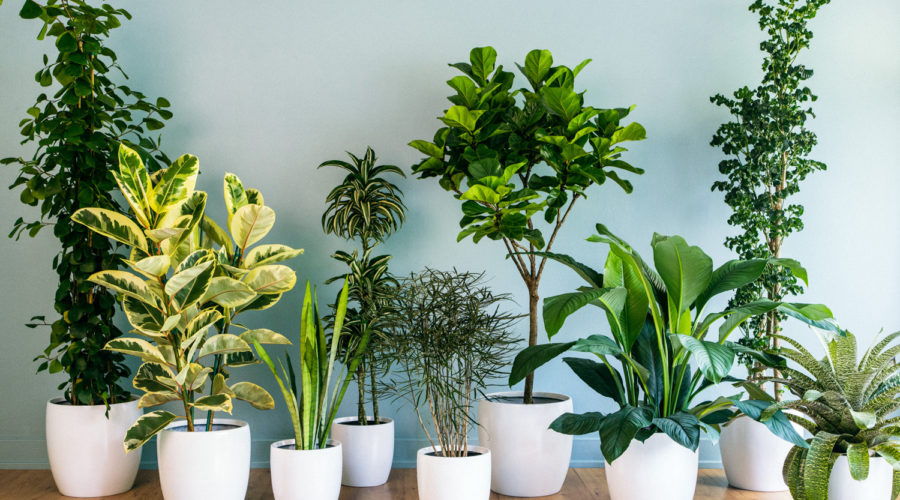HOUSEPLANTS:
- BONSAI
- ORCHIDS
- DEVIL'S IVY OR ENGLISH IVY
- SYNGONIUM PODOPHYLLUM
- PHILODENDRON
- PEACE LILY
- CHINESE MONEY PLANT OR MONEY PLANT
- FEMALE DRAGON
- DUMB CANE/LEOPARD LILY
- CHINESE EVERGREEN
- SPIDER PLANT
- FICUS
- COLEUS
- RED-EDGED DRACAENA
- BOSTERN FERN
- GOLDEN POTHOS
- SNAKE PLANT
- BAMBOO PALM
- RUBBER PLANT
- ALOE VERA
- KALANCHOE
- CHINESE EVERGREEN
- ARECA PALM
- DIEFFENBACHIA
- PEPEROMIA
- WARNACK DRACAENA
- FIDDLE-LEAF FIG
- GERBER DAISY
- DWARF AZALEA
- UMBRELLA TREE
- WAX BEGONIA OR BEGONIA
- GERANIUM
- FIDDLE LEAF FIG
- JADE
HERBS:
- MINT
- OREGANO
- BASIL
- ROSEMARY
- LAVENDER
- SAGE
VEGETABLES ARE GROWN WITH EXPANDED CLAY AGGREGATE AS A SOILLESS MEDIUM
- SPINACH
- LETTUCE
- WATERCRESS
- CHERRY TOMATOES
- CUCUMBERS
- PEPPERS
- KALE
- STRAWBERRIES
- MINT
- BASIL
- BOK CHOY
- CELERY
For any plant, while the cut is still fresh, place the plant segment in a glass container or globe with Expanded Clay Aggregates and water. Because the new plant will receive all of its nutrients from the water, the type of water is key here. Use bottled water or well water rather than tap water, which is often stripped of nutrients thanks to filtration and chlorination.
Helpful Tips for Growing Plants Indoors with Expanded Clay Aggregates
Here are a few additional tips and considerations to keep in mind for your new hydroponic garden:
- Lighting: Just because a plant is grown in water doesn't necessarily mean it doesn't still need sunlight. Especially in the case of fruits and vegetables like tomatoes and most anything with flowers, you'll need to either place your plants near a south-facing window or figure out some other way to get them much-needed light—ideally at least six hours a day. Unfortunately, this can be very complicated due to various spectrums of light, intensity, and power, not to mention the different needs of different plants.
- pH Level: Depending on what you're trying to grow, not having the optimum pH level of your water can greatly diminish your plants' ability to absorb vitamins, carbohydrates, and other nutrients. (For instance, most of the herbs mentioned above thrive in a pH level that is lower than that of most tap water.) So it's important to check the ideal pH preferences of your plants and adjust the water accordingly.
- Climate/Temperature: Like most plants prefer a temperature between 60–80°F or 15-26°C, it's important to keep an eye on how hot or cold it gets around you’re your growing garden. Sometimes you'll need to protect it from the heat generated by your grow lamps or a nearby radiator or temperature. Other times you'll need to protect them from falling temperatures in the winter or rising temperatures of summer, even though they're indoors.
What is the nutrient film technique (NFT)?
Nutrient film technique (NFT) is an active hydroponics system where water containing dissolved nutrients is pumped into a grow tray so that those nutrients can be absorbed by plants as the water passes through their roots. That water is then drained into a lower reservoir to be eventually pumped back through the grow tray.
It is one of the most popular and versatile systems for hydroponics and can be particularly useful for fast-growing, lightweight plants like lettuce—though it is not as effective for growing heavier crops such as tomatoes.
Watch your budding plant frequently for signs of rooting, which typically begins after 2 weeks. When the water runs low, top it off with some more bottled water.



Leave a Comment
Your comments added successfully.Thank You!